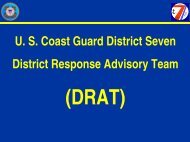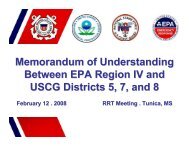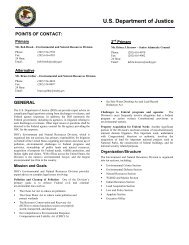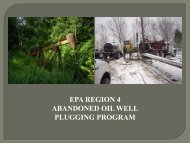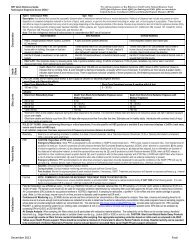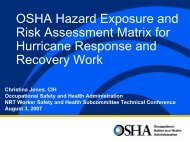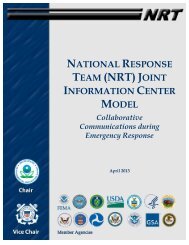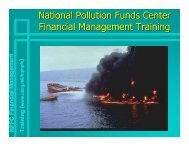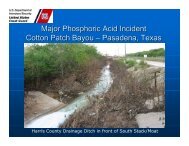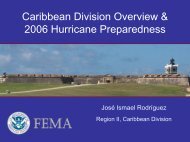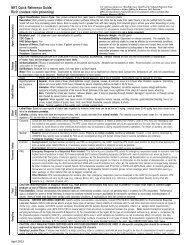USE OF DISPERSANTS - U.S. National Response Team (NRT)
USE OF DISPERSANTS - U.S. National Response Team (NRT)
USE OF DISPERSANTS - U.S. National Response Team (NRT)
- No tags were found...
You also want an ePaper? Increase the reach of your titles
YUMPU automatically turns print PDFs into web optimized ePapers that Google loves.
involved with dispersant operations.E. HAZARD EVALUATIONCrude oilsComposition: Crude oils are composed of indefinite number of hydrocarbon compounds. Most crude oils containbenzene, up to 1 percent by volume. Crude oils also contain toluene, xylene, naphthalenes, & PolyAromaticHydrocarbons (PAHs) in concentrations that vary widely depending on the source of the oil, weathering, and aging.Hazard Description: Crude oil may cause dermatitis by skin contact; nausea by inhalation; and eye irritation.Benzene is a hematological toxin (it affects the blood and blood forming organs), and is a carcinogen. The mostsignificant hazard from benzene, toluene, and xylene is in poorly ventilated areas (such as pits or under docks), oraround freshly spilled oil. Benzo(a)pyrene is a skin contact hazard and potentially may cause skin cancer withchronic skin contact. As oil weathers and ages, benzo(a)pyrene becomes more concentrated because it evaporatesmuch slower than other chemicals in the mixture.Basic Precaution: Stay away from, or upwind of, fresh oil spills; wear chemical resistant clothing as necessary toprotect against skin or eye contact; periodically change protective clothing that has oil on it; immediately changeclothing that is showing evidence of oil penetrating to your skin; and wash skin with soap and water if contact withoil occurs. Flush eyes with water if oil gets in them. If ingested do not induce vomiting, contact a physician. Userespiratory protection when volatile organic compounds and specifically benzene concentrations exceed OSHA PEL.Exposure limits of interest:benzenetoluenexylenenaphthalenehexanecoal tar/coal tar pitch volatiles1 ppm (OSHA)100 ppm (OSHA)100 ppm (OSHA)10 ppm (ACGIH)50 ppm (OSHA)0.2 mg/m3 (OSHA/ACGIH)Dispersants ApplicationDispersants act like detergents. They reduce the surface tension of the oil and break it into tiny droplets. The oildroplets are then mixed in the water column and disperse. To be effective, dispersants keep the droplets apart, andprevent coagulation. Early dispersants (late 60') contained fairly strong and toxic solvents that were used for clean upof oil tanks or mechanical equipment. They were quite toxic, both to marine organisms and to human. Thedispersants currently in use are much less toxic. They contain a surfactant mixed with a solvent, and possibly otherchemicals that serve as stabilizers. The solvents currently in use are water, alcohol, glycol, or ethylene glycol.When applied, dispersants are sprayed on the oil slick, most likely by aircraft. Flying altitude during application isexpected to be 50 to 100 feet above the water. The droplets should be large enough to settle rapidly on the slick.Smaller droplets may remain suspended for a longer period of time, and be carried downwind over some distance.Health HazardsInhalation of droplets is the most likely route of exposure to dispersant. The toxicity of the solvents now in use isrelatively low, and the concentration, if safe operating procedures are used, is not expected to be above the level ofconcern. Overexposure to the solvent in dispersants, which are the compound of most concern, may cause nausea,dizziness, headache and skin and eye irritation. These are the symptoms to watch out for. See attachment 3 forMSDS for Corexit 9527All persons coming in contact with the dispersants should read and understand the material safety data sheet (MSDS)of the dispersant to be used. The hazards of contact, symptoms, and preventive measures should be understood andfollowed.Protection



